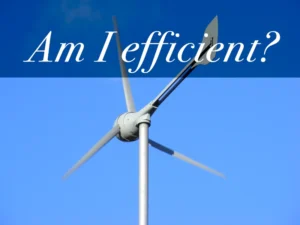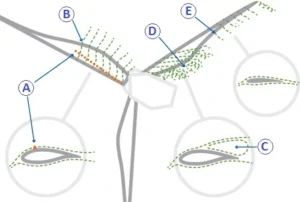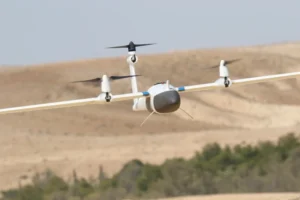Wind Turbine Efficiency Calculator
A wind turbine efficiency calculator is a useful tool for comparing two wind turbine generator models or simply testing the efficiency of your own. We have written a detailed article for those who want to know the exact formulas for calculating efficiency. But let’s take a quick look at how the simplest version of this tool works.

How to get the data required for measurement
To obtain the data required to calculate the efficiency of a wind turbine, it is necessary to collect information on wind speed (mph) and power generated (kW). Wind measuring instruments, such as anemometers or weather stations, can be used to measure wind speed. With a portable anemometer you simply have to read the value indicated near your turbine.
To measure the power generated by the wind turbine, an electrical power tester or meter must be used. This instrument allows you to measure the amount of electrical power produced by the wind turbine in kilowatts (kW). This should then be connected directly to the generator output cables.
Wind Turbine Efficiency Calculator
Optimal Result Values
The optimal values of the efficiency calculation may vary depending on the specifications of the wind turbine and local conditions, but in general, a good efficiency is between 30 percent and 45 percent. An efficiency above 45% can be considered excellent, while values below 30% may indicate that the wind turbine is not fully utilizing the available wind potential. This calculation is valid regardless of the type of wind turbine you are testing and fits all models.
FAQ
What is the Wind Turbine Design?
Wind turbine design includes creating its structure and necessary components. The key elements are the rotor blades, hub, nacelle, generator, gearbox, yaw system, tower, and foundation. All these components must work together perfectly to capture the maximum amount of wind energy and convert it into electricity. The design aims precisely to optimize this energy capture as well as efficiency and reliability. It also takes into account factors such as aerodynamics and structural integrity.
What are the different types of wind turbines?
There are mainly two main types of wind turbines: horizontal-axis wind turbines (HAWTs) and vertical-axis wind turbines (VAWTs). HAWTs, with their blades rotating around a horizontal axis, are the most common and recognizable. They are highly efficient and suitable for large-scale applications.
VAWTs, on the other hand, have blades that rotate around a vertical axis and are often used for small-scale or urban installations, as they can capture wind from any direction.
How many houses can power a wind turbine?
The number of houses powered by a wind turbine depends on several variables. If we talk about modern onshore wind turbines, they generally have a capacity of between 2 and 3 megawatts (MW). To estimate the number of houses powered, it is necessary to consider the average local wind speed, capacity factor, and energy consumption of the houses.
For example, in an area with favorable wind conditions and a high capacity factor, a 2 MW turbine could generate enough electricity annually to power about 500 homes. However, in an area with lower average wind speed and a lower capacity factor, the same turbine could only provide enough energy for about 200 to 300 homes.
Is it important to explain wind power to children?
Explaining the importance of wind energy to children is crucial to raising their awareness of the environment and sustainability. This teaching helps them understand how wind can be used to generate clean energy, promoting awareness about renewable energy and preparing them for a future where environmental protection will be crucial. It also inspires them to support green initiatives, save energy, and consider innovative solutions for a more sustainable world.


4 thoughts on “Wind Turbine Efficiency Calculator”
Comments are closed.